
First we had Secretary of Transportation Pete Buttigieg talking about “racist roads.” Then we had the city of Oakland, California, remove traffic lights because public officials were unwilling to stop thieves from stealing copper from them. Now there’s yet another indication of what many consider our descent into idiocracy and social decay:
Los Angeles has removed “homophobic” “no u-turn” signs.
Well, it’s good to see elected representatives being about the people’s business.
BPR reports on the satire-like, but all too real story:
Los Angeles City Council members have removed seemingly innocuous traffic signs from a neighborhood, claiming that they were homophobic.
In a move that drew mockery and scorn on social media, the signs were taken down in a gesture of goodwill to the very special demographic for “Pride” month, a 30-day national celebration of homosexuality and other alternate sexual lifestyles.
The offensive signs which read “No cruising. No U-turns. Midnight to 6 am” had been put up in 1997 in the city’s Silver Lake neighborhood “with the intent to curb gay men from roaming the streets to hook up,” according to the Los Angeles Times.
“Los Angeles has a rich history of welcoming the LGBTQIA+ community, but there has also been real and present homophobia — which at times has been inscribed into the city’s physical spaces, as with these no-U-turn signs,” said District 4 Councilmember Nithya Raman in a statement.
Providing more details, the Los Angeles Times writes that in “the late 90s when the internet was still new and gay dating apps like Grindr did not exist, queer men sometimes relied on printed guidebooks that listed public areas where they could find love, sex and community without outing themselves.”
“Among those areas was West Hollywood, where anti-gay traffic signs similar to the ones removed Monday were installed in 1991 and later removed — and Griffith Park Boulevard in Silver Lake, where Soto-Martinez [another city councilman complicit in the signs’ removal] and Raman’s districts now meet,” the paper continues. “The area is also where more than half a dozen bars, all within a 2-mile radius, serve a thriving queer clientele between East Hollywood and Silver Lake.”
Obviously proud of his woke handiwork, Councilman Hugo Soto-Martinez sent the following tweet.
Responding to this, however, commenters in the know pointed out that Soto-Martinez was misrepresenting the history in question.
“What a complete lie, joke, and mockery of the gay community,” writes one poster, who identifies himself as a homosexual who’d been part of the problem. “These signs went up ALL OVER socal in the 90’s. We had a ridiculous car cruising culture. Lowered trucks and stuff. I used to be one. I am also gay. We were creating traffic and a nuisance. Drugs. Stop lying.”
His tweet, along with that of a respondent who affirms his assertion, are below.
Other observers were just aghast at the L.A. Council’s askew priorities. “How is a no u turn sign homophobic?” BPR related Outkick founder and nationally syndicated talk radio host Clay Travis as saying. “What am I missing here? This is bonkers.”
“There’s so much crime in Los Angeles but this is what they’re concerned about,” a twitter user wrote.
“We are almost back at the level of caveman intelligence,” another added. “Actually cavemen were probably smarter.”
Yet another quipped, “Nice[,] now paint a pride flag at that intersection so I can make a U-Turn on it!”
Striking a more serious note, a different poster stated that he “would love to see a traffic study done to see how many more car accidents begin happening there, [sic] hopefully they won’t be fatal accidents.”
This actually brings us to a deeper issue, too. That is, distracted by the alleged intention behind the signs’ erection, a simple matter is overlooked: Is their presence a good idea?
Also realize that this intention-über-alles mentality isn’t limited to street signs. Just consider a 2018 judicial ruling stating that while President Trump did have the authority to end DACA (Deferred Action for Childhood Arrivals), he must provide what the court considers “adequate reasons for doing so.”
Interestingly, the courts didn’t demand “adequate reasons” from Barack Obama when he instituted DACA in the first place. Regardless, however, an executive action either is constitutional or it isn’t; or, in a case in which all options are constitutional (as with the L.A. traffic signs), the action either is a good idea or isn’t. The intention behind it is irrelevant to these matters.
In fact, government does things for the wrong reasons all the time. Just consider the Johnson Amendment, a 1950s tax-code provision that bars non-profits from endorsing or opposing political candidates. Then-senator Lyndon Johnson (D-Texas) pushed it for an entirely self-serving purpose: A wealthy man was using a non-profit against him in a reelection campaign. Does this mean the provision should be ruled unconstitutional? (I believe it’s unconstitutional for different reasons.) If impure intent were enough to scuttle a government law or measure, how many would remain?
It’s interesting that the very people who claim the original intent of the Founders is irrelevant when interpreting the Constitution — that the document can be considered “living” and applied to suit the “times” — suddenly believe intent is everything with respect to other laws and actions.
Why, an observer could get the funny idea that this has nothing to do with principle and everything to do with finding rationalizations for a very dark impulse: “Let my will be done.”



